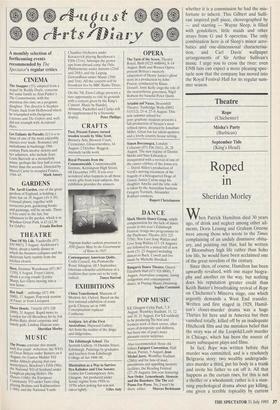Dance
Ballet Atlantique (Queen Elizabeth Hall)
Music and movement
Sophie Constanti
Regine Chopinot's Ballet Atlantique has become one of the few choreographer- led troupes in France to open its doors to other dance-makers. To mark her compa- ny's adoption of the repertory system, Chopinot chose to extend her first commis- sion for a new ballet to the British choreo- grapher Richard Alston whose work she has long admired. Working with Chopinot's 12 dancers at La Rochelle last autumn (while he was still artistic director of Ram- bert Dance Company), Alston was given adequate space, time and resources to cre- ate a 40-minute work set to, and named after, Pierre Boulez' Le Marteau sans Maitre. Sharing the stage with the excellent Ensemble InterContemporain (conducted by David Robertson and joined by soprano Luisa Castellani), Ballet Atlantique's dancers seem a natural and necessary accompaniment to a score which does not register as immediately danceable. Yet Alston finds a hidden incitement to physi- cal response and his dancers elucidate the music, enriching its textures, delving into its complexities and highlighting its con- stant shifts of pace and mood.
Alston does not attempt a literal inter-
pretation of Rene Char's three poems which form the songs of Boulez' composi- tion, and which he describes as dense and ambiguous. Instead, he constructs long, unbroken, sensitively modulated passages of movement in which one can see and hear the changing structures of the score. Most compelling are the duets for two cou- ples — Michele Prelonge and Pascal Sera- line (in white body stockings) and Regine Chopinot with Joseph Lennon (clad in black). As a dancer, Chopinot hungrily grasps every nuance in the speed and mood of Alston's material. Unfortunately, Jean- Charles Blais' set designs could not be accommodated in full at the QEH. Howev- er, the economy version — a large, silvery mobile which, beneath Gerard Boucher's lighting, created a dark pool placed in shadow one moment and on a frosty white plain the next, issued just the right measure of sparse beauty to the occasional and gen- tle turbulence of Alston's writing.
Ballet Atlantique's all-Alston double bill also featured the choreographer's Rainbow Bandit, one of his brightest, rhythmically clever works. Few of Chopinot's dancers possess the sharp agility and precision which is so vital if their actions are to match the verbal punch of Charles Amirkhanian's sound-poetry, but their commitment to Alston's choreography shines through all the difficulties posed by its shape and drive. As for Le Marteau sans Maitre, Alston has given the company a gift which it strives to honour. In performance one sees the dancers explore, process, per- sonalise and understand the combination of Alston's movement and Boulez' music. No such absorbing inseparability of ele- ments was to be found just across the river. English National Ballet, in a show designed for the re-opening of the Savoy Theatre three years after it was destroyed by fire presented a triple bill of oddments. It kicked off with Frederick Franklin's ver- sion of the Grand Pas Classique from Act III of Raymonda which proved more bland than grand: Maria Teresa Del Real and Christian Duncan efficient but unmemo- rable in the principal roles. The Portuguese choreographer, Olga Roriz, provided the obligatory, modern Euro-ballet of the evening with The Seven Silences of Salome, her exhausting and baffling work for seven of the company's butchest men who here spend much of the time wearing multiple skirts over their trousers and, for reasons unknown, dancing until completely breath- less. Roriz gives each man a solo — fine performances from Denzil Bailey, Stephen Sheriff and Thomas Edur — and exploits the phenomenal levels of energy and strength seldom unleashed in full by male ballet dancers, but her work is marred and weakened by its reliance on repetitive ges- ture.
The Savoy performances herald Derek Deane's first London season as artistic director of ENB. Little is known of his policies, but it is likely that the supply of Ben Stevenson 'classics' which, under Ivan Nagy's rule, dominated the repertoire, will begin to disappear. This is good news, but there is always the possibility of bad, or worse, replacement ballets. For instance, we do not fully know whether Deane is entirely responsible for Savoy Suite or English National Ballet: Denzil Bailey in The Seven Silences of Salome, with music by Antonio Emiliano, choreographed by Olga Roriz
whether it is a commission he had the mis- fortune to inherit. This Gilbert and Sulli- van inspired puff piece, choreographed by — and starring — Wayne Sleep, is filled with gondoliers, little maids and other strays from G and S operettas. The only combination here is of Sleep's minor acro- batics and one-dimensional characterisa- tion, and Carl Davis' wallpaper arrangements of Sir Arthur Sullivan's music. I urge you to cross the river: even ENB fans can expect a more pleasing spec- tacle now that the company has moved into the Royal Festival Hall for its regular sum- mer season.



















































 Previous page
Previous page